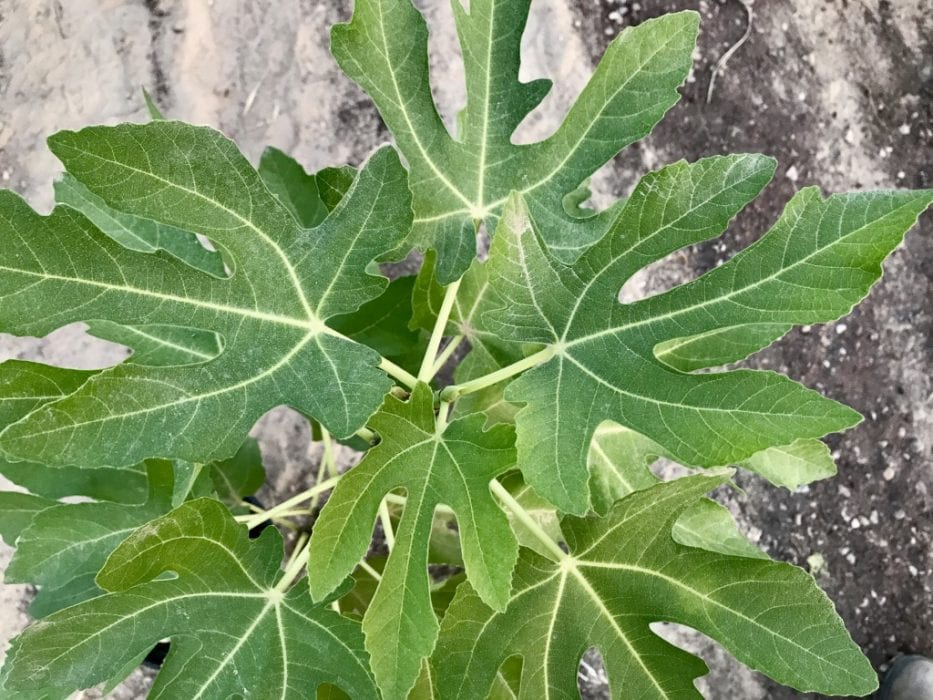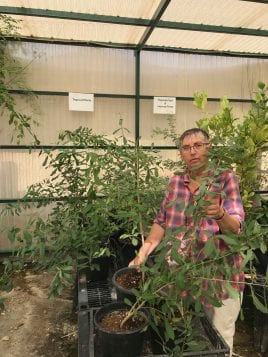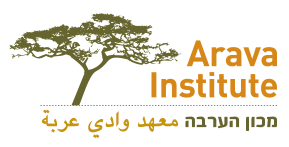CSA Staff
DR. OREN HOFFMAN Director
oren@arava.org
NOAH MARTHINSEN Research Manager noah@arava.org
DR. ELAINE SOLOWEY Researcher emerita elaine.solowey@arava.org

MIDDLE EAST MEDICINAL PLANTS (MEMP)
Dr. Solowey’s Middle East Medicinal Plant Project (MEMP), which is sponsored by the Louis L. Borick Natural Medicine Research Center of Hadassah Hospital, aims to protect and propagate the rare medicinal and biblical plants of the Southern Negev and Dead Sea area. The research has informed innovative pharmaceutical treatments for cancer and malaria and has implications for the preservation of endangered medicinal plants. Dr. Solowey’s team domesticates these species so that the plant material is available for research without disturbing the wild populations. She has cultivated, among other species, rare members of the Artemisia family from which malaria-fighting drugs have been extracted, and neem trees, which have so many medical uses in India that they are known as the “pharmacy of the village.”
RECENT PROJECTS
Flora Palestina Open-Source Database
A long-term Middle East Regional Cooperation (MERC) collaborative project between several partners, the online database will be released in 2020 in English, Arabic, and Hebrew. The open-source database provides easy access to information about thousands of botanical species in the Flora Palestina region in order to preserve the traditional and botanical knowledge and promote conservation.
| Species – Botanical Name | Parts Used | Complaint/Use | System/State | Actions | Preparation/ Administration |
|---|---|---|---|---|---|
| Marrubium vulgare L. | Whole plant | Eczema | Dermatology | Anti-pruritic | Cook the non-woody parts in sesame oil and prepare a salveclove |
| Marrubium vulgare L. | Diabetes | Endocrine/ Metabolism | Anti-diabetic | ||
| Marrubium vulgare L. | Whole plant | Abdominal pain | Gastrointestinal | Analgesic | Cook in water and drink |
| Marrubium vulgare L. | Whole plant | Inflammations of the liver | Endocrine/ Metabolic | Hepatic | Decoction in water ,drink with sugar |
| Marrubium vulgare L. | Whole plant | Rheumatic pain | Musculoskeletal/ Joints | Analgesic | 1 in bathwater with salt 2 asincense prepared with salt and sheba (alum) |
| Marrubium vulgare L. | Whole plant | Expectorant | Respiratory | Anti-catarrhal | Decoction in water drink |
| Marrubium vulgare L. | Whole plant | Wounds skin lesions | Wound Healing | vulnerary | Cook the non-woody parts in sesame oil and prepare a salve |
| Marrubium vulgare L. | Whole plant | Antiseptic for skin/ wounds lesions | Wound Healing | Anti-septic, vulnerary | Apply the juice on the skin or the purulent lesion |
| Matricaria chamomilla L. | Flower | Internal tumors | Cancer | Anti-cancer | Mix flowers with Saliva sp.Majorana syrica Rosemary officialis |
| Matricaria chamomilla L. | Flower | Abdominal spasms in babies | Child health | Anti-spasmodic | Drink decoction of the flowerswith Pimpinella anisum |
| Matricaria chamomilla L. | Flower | Intestinal inflammation in babies | Child health | Anti-inflammatory | Drink decoction of the flowerswith Pimpinella anisum |
| Matricaria chamomilla L. | Flower | Regulate the digestive system in cases of diarrhea in babies | Child health | Anti-diarrhoeal | Drink decoction of the flowerswith Pimpinella anisum |
| Matricaria chamomilla L. | Flower | Regulate the digestive system in cases of constipation in babies | Child health | Laxative | Drink decoction of the flowerswith Pimpinella anisum |
| Matricaria chamomilla L. | Flower | Ear, Nose, Throat (ENT) | |||
| Mentha pulegium L. | Leaf, Stem | Respiratory | Anti-tussive | Cook with za’atar farsi (Coridothymus capitatus) and drink a cup before bedtme | |
| Mentha species | Whole plant | Cardiovascular | Cardiac | Cook in water with Micromeria myrtifolia or Salvia Triloba. Drink | |
| Mentha species | Leaf, Whole plant | Child health | Unspecified | Take a large tablespoonof decoction before bedtime |
| ID | Botanical Name | Family | English Names | Hebrew Name | Hebrew Name (Phonetic) | Arabic Name (Phonetic) |
|---|---|---|---|---|---|---|
| 71 | Artemisia herba – alba Asso. | Asteraceae | White Wormwood (Herba-alba) | לענתהמדבר | La’anat ha-midbar | Shikh |
| 72 | Artemisia monosperma Del. | Asteraceae | Sand Wormwood | לענה חד-זרעית | La’ana khad zir’it | Keysoon |
| 73 | Artemisia judaica L. | Asteraceae | Judaean Wormwood | לענת יהודה | La’anat Yehuda | B’ei’tran |
| 15 | Achillea fragrantissima (Forssk.) Sch. Bip. | Asteraceae | Lavender Cotton | אכילאה ריחנית | Achillea rehanit | Qassum,Bissum |
| 52 | Anthemis psuedocotula Boiss. | Compositae | Common Chammomile | קחוון מצוי | Kakhvan matzuy | Kakhwan |
| 3 | Anethum graveolens L. | Apiaceae | Dill | שבת ריחני | Shevet rehani, Shamir | al ‘asba-al-hlalya,Shibid |
| 5 | Capparis spinosa L. | Capparaceae | Caper | Zalaf qozani | Qubar (Folk),Qabar (Li teral),Lazaf | |
| 6 | Ceratonia siliqua L. | Leguminosae-caesalpinioideae | Carob Tree,Locust tree | חרוב מצוי | Haruv mazuy | Kharub,Kharnub (literal) |
| 7 | Coridothymus capitatus (L.) Reichnb. | Lamiaceae | Headed Thyme | קורנית מקורקפת | Koranit mekurkefet | Za’atar,za’atar pharsi,Zucheif |
| 14 | Acanthus syriacus Boiss. | Acanthaceae | Bear’s Breech (A. mollis) | קוציץ סורי | Qoziz suri | Khanziri |
| 15 | Achillea fragrantissima (Forssk.) Sch. Bip. | Asteraceae | Lavender Cotton | אכילאה ריחנית | Achillea rehanit | Qassum,Bissum |
| 16 | Adianthum capillus-veneris L. | Adiantaceae | Southern Maidenhair Fern,Venus’s Hair,Rudder Gra | שערות-שןלמית מצויות | Se’arot-shulamit mezuyot | Sha’ar-el-khanzir,Kuzbarat-el-Bir,Sha’ar-el-ard |
| 20 | Ajuga chamaepytis (L.) Schreb. | Lamiaceae | Ground pine, Chian Bugle | חד-שפה מצוי | Had-safa mazuy | Shandaqur,’Ishbt-el-dzantria |
| 21 | Alhagi graecorum Boiss. | Leguminosae-papilionoideae | Camel Thorn | הגה מצוי | Haga mazuy | Al-‘aqul,Shirs-el-‘aqul,Shoq-el-Gamal |
| 22 | Alhagi camelorum Fisch. | Leguminosae-papilionoideae | Camel Thorn | הגה מצוי | Haga matzui | Tranjamin,Tranjamsh |
| 23 | Aaronsonia faktosovskyi | Asteraceae | אהרונסונית פקטורובסקי | |||
| 28 | Alhagi maurorum medik | Leguminosae-papilionoideae | ||||
| 31 | Allium ampeloprasum L. | Liliaceae | Wild Leek | Shum Gavoha – auo dcuv | Kurat | |
| 33 | Allium neapolitanum Cyr. | Liliaceae | Neaple’s Garlic | שום משולש | Shum meshulash (=triangular garlic) | Tum Ar-raghr |
| 34 | Alkanna strigosa Boiss | Boraginaceae | Strigose Alkanet | אלקנה סמורה | Alkanna Samura | Hawa Juwani |
| 39 | Althea officinalis L. | Malvaceae | Marsh Mallow | חטמית רפואית | Netofitt refu’it medicinal chotmit | Altea |
| 41 | Althea setosa Boiss | Malvaceae | Bristly Hollyhock | Khotmit zifanit prickly Khotmit) | Ward el-Chasad |

Neem
This project joins commercial crop development and studies on healing plants. From 2004-2014 The Center worked on making the neem tree salt tolerant. After ten years, the results of selection and breeding were successful; between 2014-2015, three hundred trees were planted at neighboring kibbutz Lotan. More salt-tolerant neem trees will be planted in other locations this year. Neem is a highly medicinal tree, with each part of the plant in use as an anti-fungal, anti-bacterial, and an anti-diabetic.

The anti-cancer plants garden, another project of Middle East Medicinal Plants (MEMP), is in the early stages of planning. The garden will feature twenty-six species of native desert plants that The Center has researched over the years for anti-cancer properties. Annual and perennial species will be grown to supply further research and materia medica without threatening wild populations.
Solowey E, Lichtenstein M, Sallon S, Paavilainen H, Solowey E, Lorberboum-Galski H. Evaluating Medicinal Plants for Anticancer Activity. The Scientific World Journal Volume 2014 (2014), Article ID 721402, 12 pages http://dx.doi.org/10.1155/2014/721402
Harlev, E., Nevo, E., Solowey, E., & Bishayee, A. (2013). Cancer Preventive and Curative Attributes of Plants of the Cactaceae Family: A Review. Planta Medica, 79(09), 713–722. doi: 10.1055/s-0032-1328632

